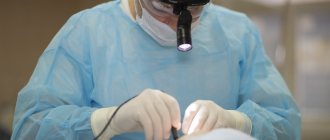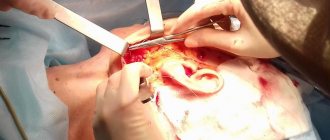Consultation with plastic surgeons with over 20 years of experience is free! Make an appointment by phone. Waiting for you! When we talk about levatoroplasty, we almost always mean posterior colporrhaphy. Together, these two operations effectively strengthen the vaginal walls and pelvic floor muscles, preventing organ prolapse and allowing a woman to live a full and healthy life. Strengthening or suturing torn perineal muscles is often necessary after childbirth. This explains the popularity of posterior colporrhaphy with levatoroplasty in our clinic.
Where are the levators located, and why do doctors have to perform their plastic surgery?
These large muscles, each of which consists of three smaller ones, are part of the pelvic floor - a complex structure that serves as a support for the pelvic organs - the rectum, bladder, uterus and vagina. Levators lift the anus and hold the contents of the rectum, and also help lock urine inside the bladder.
Layout of the pelvic floor levator muscles
Dense muscles close the entrance to the vagina and prevent it from being constantly open - gaping.
Another important function of the levators is to resist increased intra-abdominal pressure that occurs when coughing, sneezing, laughing, and physical activity. Thanks to them, the pelvic organs maintain their correct position during muscle tension and clearly perform their functions.
Weakening or damage to the levators leads to serious consequences:
- The pelvic organs, deprived of support, cannot function normally. Women develop urinary incontinence and may have problems emptying the rectum and retaining gas. Displacement of the vagina and uterus negatively affects the quality of intimate life.
- If the levators are significantly damaged or stretched, the organs may fall out. The situation increases gradually - first there is partial and then complete loss. Sometimes organs even end up outside the body. Their function is completely lost, which leads to serious complications - urinary retention, intestinal obstruction, tissue damage and bedsores.
- Approximately 6% of women suffer from a disease caused by spasm of the levator muscles. The disease manifests itself as unpleasant sensations in the form of tension or pressure in the anus. The cause of the disease is still unknown, but it is assumed that it is caused by injury to muscle structures accompanied by nerve damage.
To eliminate these disorders, levatoroplasty is performed - an operation during which the doctor restores torn, damaged or stretched muscles, creating a new support for the pelvic organs.
Very often, at the same time, a gynecologist surgeon removes organ prolapse. For example, doctors often perform posterior levatoroplasty with colporrhaphy, an operation during which the levator muscles are restored and the prolapse of the vaginal walls is eliminated.
Levatoplasty: what is it and how is the operation performed?
Weakening of the pelvic floor muscles - the levators - occurs in many women. Most often, the cause of pathology is complicated childbirth.
Levatoplasty is a surgical operation whose purpose is to restore the strength of the muscle frame in the perineal area. Performed under general or epidural anesthesia. In the future, the woman who has undergone the intervention has no obstacles to spontaneous childbirth. In what cases will the operation be effective, how difficult can the rehabilitation be and how much money will it require? TecRussia.ru tells in detail:
↑ Features of the intervention
The main goal of levatoroplasty is to restore the elastic muscle ring at the entrance of the vagina, in its lower third, which is called the orgasmic cuff. It is these muscles that maintain the normal position of the vagina and anus and contract during sexual stimulation. Weakening of the levators and even disruption of their integrity often results from ruptures during childbirth. This leads to consequences such as:
- prolapse of the pelvic organs - uterus, rectum, bladder;
- problems with bowel movements, increased urge to urinate;
- gaping of the vagina, asymmetry of its vestibule;
- psychological discomfort during sexual intercourse.
Unlike perineal plastic surgery, which promotes the formation of normal proportions in this area, levatoroplasty is aimed at restoring the functions of muscle tissue.
↑ Indications for surgery
Levatoplasty is recommended for the following problems:
- After episiotomy - forced dissection of the perineum during childbirth to facilitate the passage of the fetus. Such manipulation causes not only a violation of the integrity of the muscles, but also cicatricial deformation and asymmetry of the vaginal vestibule.
- With age-related changes - decreased elasticity, tone of the tissues of the perineum, their stretching.
- When the back wall of the vagina prolapses, which causes pressure on the rectum (prolapse). This may be due to birth injuries, lack of estrogen, or surgical procedures.
- In case of prolapse of organs located in the pelvis - including when combined with gynecological pathologies.
The list of indications for intervention can be expanded - the need for this is determined by the doctor after examining the patient and determining the nature of the pathology.
↑ Contraindications
Among the prohibitions on the operation:
- severe cardiovascular diseases;
- exacerbation of infectious diseases;
- pulmonary, renal or liver failure;
- impaired blood clotting ability;
- inflammatory processes of the organs of the reproductive system;
- acute varicose veins, etc.
↑ How to prepare for surgery
Before performing levatoroplasty, the patient is prescribed a number of standard studies. The list may vary slightly, but the basics are always the same:
- consultation with a gynecologist and proctologist;
- general and biochemical blood tests;
- Ultrasound of the pelvic organs;
- Doppler ultrasound of the veins of the lower extremities;
- ECG;
- colposcopy;
- coagulogram.
The older the patient, the wider the list of studies will be - their scope is determined by the gynecologist after the examination. Also, before the operation, they find out whether the woman is allergic to substances included in the anesthetic drugs.
The evening before surgery, you need to do a cleansing enema or take a laxative in advance. The operation is performed on an empty stomach; a light dinner is allowed the night before. You need to stop drinking 2-3 hours before.
↑ How the operation goes
Levatoplasty is performed under anesthesia - general or spinal. Algorithm for performing manipulations:
- The surgeon excises a flap of skin that covers the muscles that provide support to organs - the uterus, ovaries, and bladder.
- He then identifies the main fascial bundles and sutures them together to form a secure base for the pelvic floor.
- Finally, the doctor sutures the surgical wound and applies a sterile bandage.
For the first 1–2 days, the patient is in the hospital under the supervision of medical personnel. Then, if there are no complications, he goes home. The sutures are removed after 4-6 days - already on an outpatient basis. Internal sutures dissolve on their own within 2-3 weeks.
↑ Rehabilitation period
To prevent complications, after surgery you must adhere to the following recommendations:
- You can start sitting down no earlier than 2 weeks later.
- For the first few days, you should eat light, semi-liquid foods to prevent constipation and straining during bowel movements.
- For 1.5–2 months, you need to avoid physical activity, especially heavy lifting, and give up active sports.
- Sexual contact is prohibited for 4–6 weeks.
- Until complete healing, you need to treat the external seams with special means to prevent infection.
Planning a pregnancy after such an operation is allowed no earlier than a year later - after consultation with a doctor.
↑ Possible complications, how to avoid them
As a rule, levatoroplasty occurs without significant negative consequences. Modern instruments and proven intervention technology allow us to minimize risks. However, in some cases the following may develop:
- infection, suppuration of a postoperative wound;
- bleeding;
- severe pain;
- prolonged healing.
To prevent levatoroplasty from causing serious complications (for example, damage to neighboring organs or the development of an abscess), you must, first of all, responsibly choose a clinic and a surgeon who will perform the operation. It is also important to follow the recommendations of a specialist during the recovery period. If alarming symptoms appear, it is important to seek medical help without delay.
↑ Combination with colporrhaphy
Levatoplasty is most often combined with vaginal plastic surgery to restore its anatomical shape. In most cases, the doctor’s manipulations are aimed at narrowing the organ. When combining surgery with colporrhaphy, it is possible to achieve not only the strengthening of weakened muscles, but also the elimination of external defects of the genital organs: cicatricial deformities in the perineum, unattractive anatomical features.
↑ Cost of the operation
The price depends on the volume of surgery and the status of the clinic. On average, women planning levatoroplasty should expect an amount in the range of 70,000–80,000 rubles. If we are talking about a one-time procedure and colporrhaphy, the cost may increase to 130,000–150,000 rubles.
What operations are levatoroplasty often combined with?
Levatoroplasty can be performed with:
- Perineoplasty
- plastic surgery of the perineum - the area located between the vagina and rectum. During childbirth, tears often remain in this area, which heal with the formation of scars. After plastic surgery, the perineum becomes aesthetic and tightened. - Colporrhaphy
– tightening of drooping vaginal walls. During the operation, the doctor returns the displaced rectum and bladder, which protrude into the vaginal lumen, back into place. - Vaginoplasty
is a plastic surgery of the vagina, during which the doctor sutures its walls, making the genital tract narrower and more compact. - Surgeries to treat urinary incontinence
. The most commonly used methods are sling methods, in which a mesh tape is passed under the urethra - a sling, which is raised and secured in the groin or pubic area. A hammock-like support structure is created to help stretched or damaged ligaments hold the urethra in place. As a result, the urethra can again block urine, preventing it from leaking. - Restoring the anal sphincter
- the circular muscle that locks the anus. It is performed after a difficult birth, when a woman has experienced trauma not only to the levators, but also to the muscle fibers that hold the contents of the rectum.
Mesh tape - sling for the treatment of urinary incontinence
Levatoplasty: postoperative period
The period after levatoroplasty with posterior colporrhaphy may be slightly painful due to muscle trauma, but the discomfort is temporary and can be easily relieved with painkillers. The main rule of recovery: after levatoroplasty and colporrhaphy, refrain from sitting at a right angle for up to 7 days and squatting for up to 14 days. This will prevent the seams from coming apart and ensure a good result. Complete rehabilitation takes 2 months, after which you can return to sexual activity.
Reasons leading to damage to the levators and the need for levatoroplasty
- Consequences of difficult childbirth.
Levators are damaged during the birth of large children, multiple births, incorrect presentation (position) of the fetus, too long or short and stormy labor. A study conducted at the University of Washington found that muscle damage persists in 20% of women even one year after giving birth. - Age-related changes
. Levators, like other tissues, tend to stretch with age. The process is accelerated by numerous births, heavy physical activity, and excess weight. - Violation of the structure of connective tissue
, which serves as a kind of muscle framework. These women have a reduced concentration of collagen protein, which gives tissue strength. This feature can be suspected by the tendency to form hernias, varicose veins, and joint diseases, which are also associated with low collagen levels. Therefore, such women need to closely monitor the condition of the pelvic organs, regularly visit a gynecologist, undergo an ultrasound of the pelvic organs and an MRI of the pelvic floor. - Diseases accompanied by a constant severe cough and chronic constipation
. The woman constantly experiences an increase in intra-abdominal pressure, which gradually overloads the levator muscles and leads to their stretching. - Improperly organized sports activities
. As studies conducted with athletes in the USA have shown, many women involved in strength sports, jumping, and acrobatics have problems associated with damage to the pelvic floor.
Chronic constipation
What symptoms indicate the need for levatoroplasty?
Women may not always immediately understand that they need such an operation. For some time, the function of the damaged levators is performed by other structures that support the pelvic organs, but gradually they begin to weaken and can no longer function fully.
The woman’s symptoms of prolapse are increasing. Unfortunately, patients very often ignore the first manifestations of disorders and consult a doctor very late, significantly complicating treatment. The earlier levatoroplasty is performed, the easier the intervention will be. In advanced cases, the doctor has to carry out a whole range of restorative operations.










